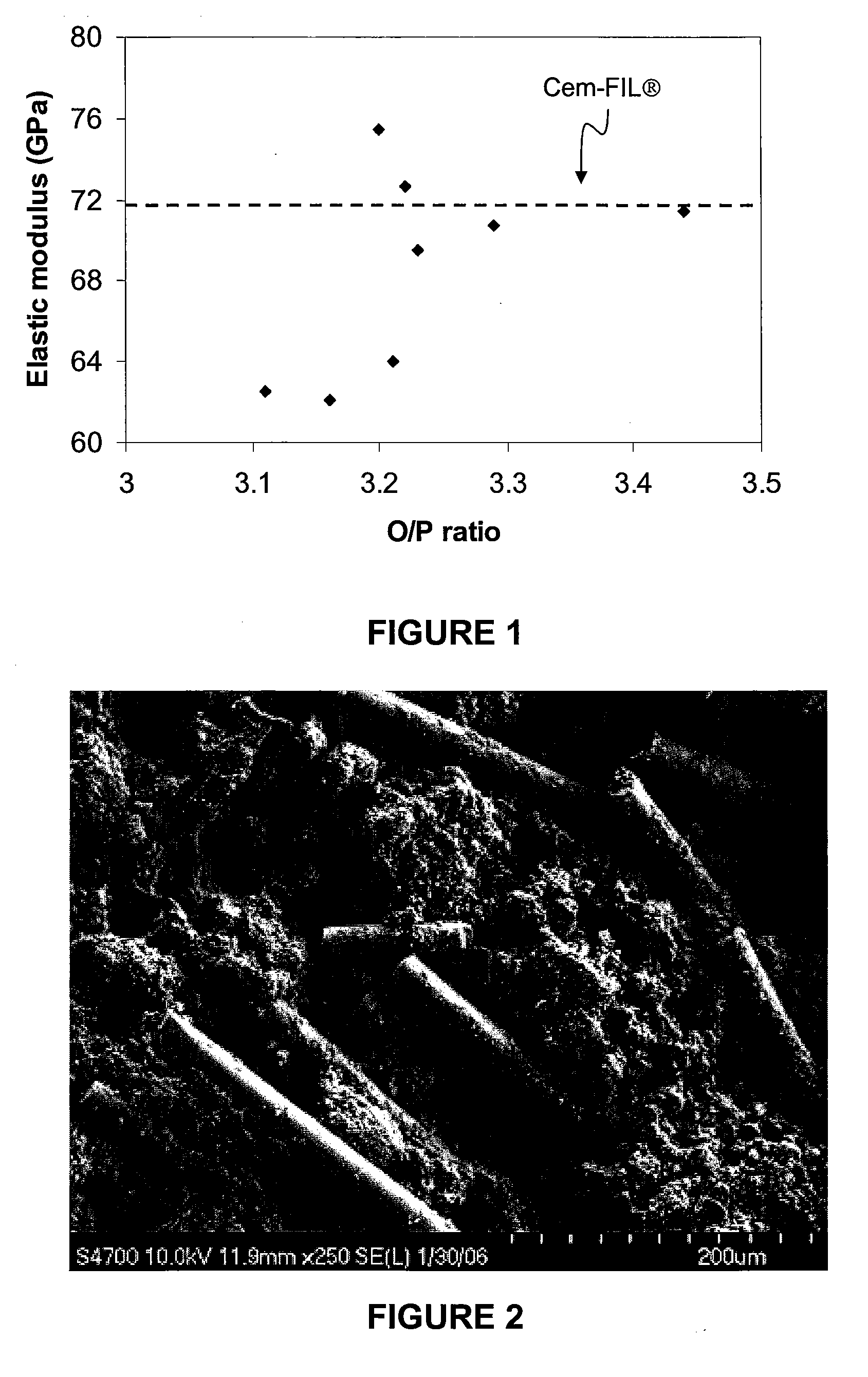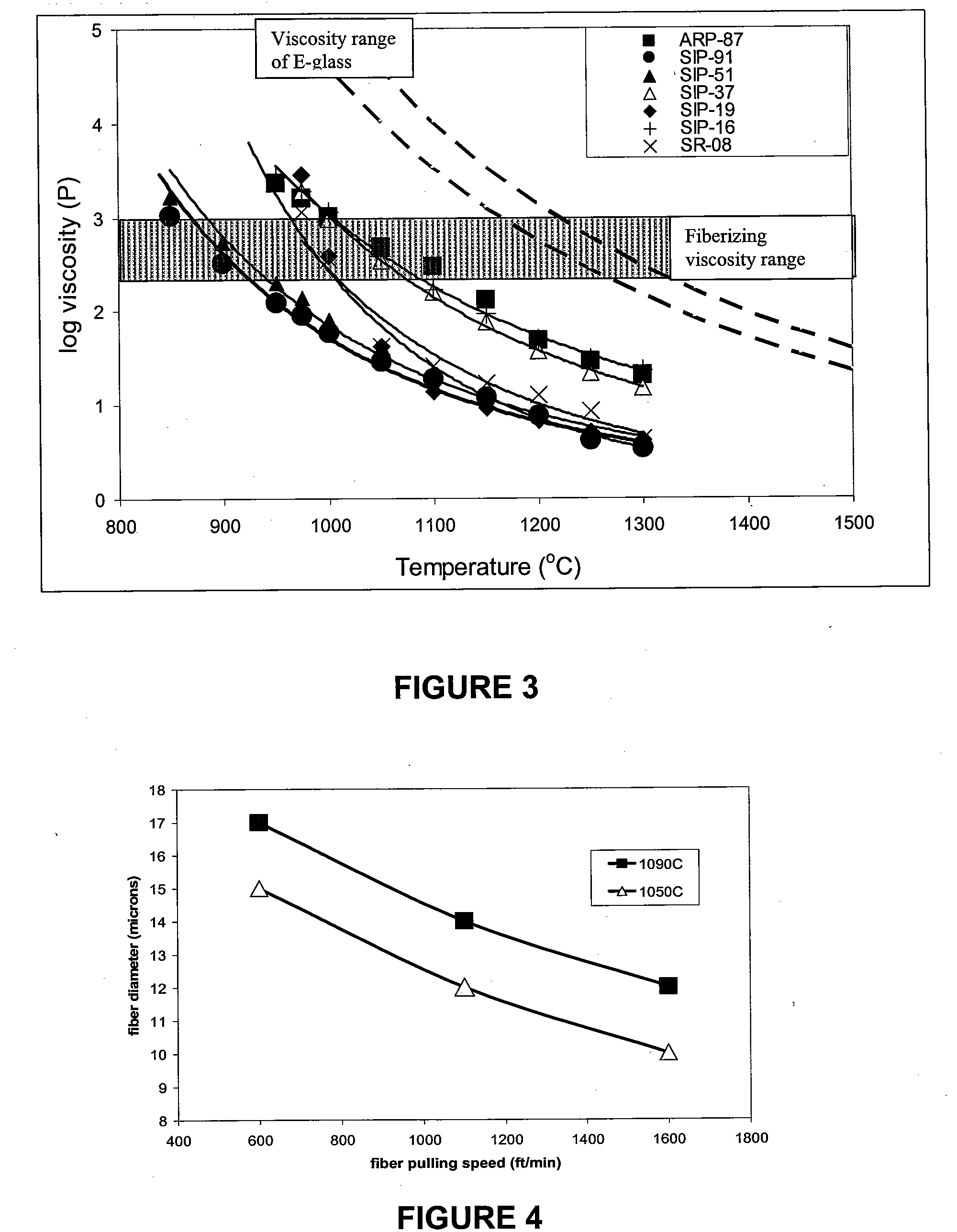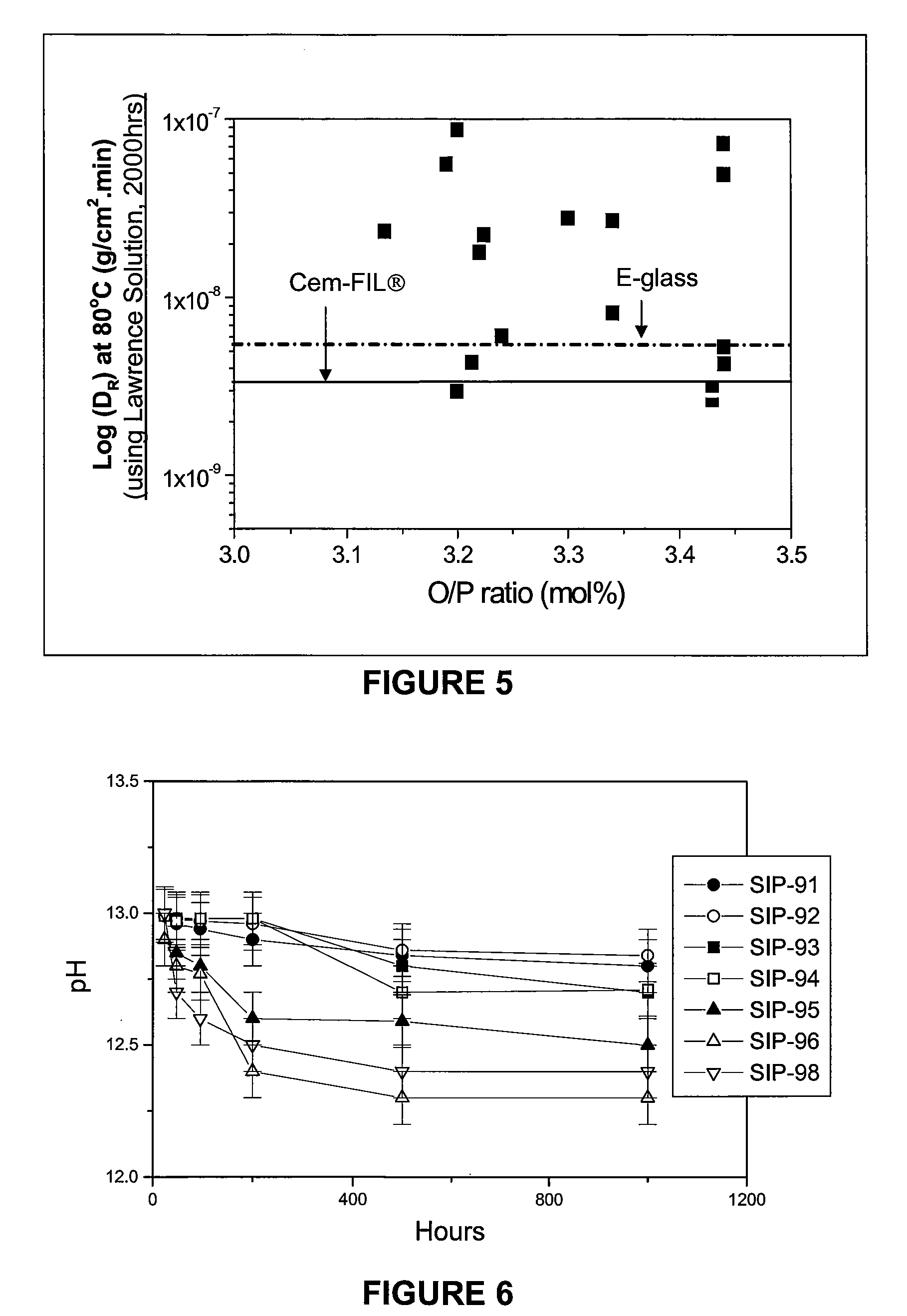Alkaline resistant phosphate glasses and method of preparation and use thereof
a technology of alkaline resistance and phosphate glass, which is applied in the direction of radioactive decontamination, coating, nuclear engineering, etc., can solve the problems of difficult to draw fibers from iron phosphate melts, the iron phosphate glasses developed to date do not possess the requisite chemical durability, and the concrete is expanded and cracked. , to achieve the effect of lowering the processing temperatur
- Summary
- Abstract
- Description
- Claims
- Application Information
AI Technical Summary
Benefits of technology
Problems solved by technology
Method used
Image
Examples
example 1
[0075]Various embodiments of CFP glass were prepared, as shown herein below in Table 1, wherein all percentages are mole percents, based on the total number of moles of the glass.
TABLE 1Data for CFP compositions.ARP-SIP-SIP-mol %87SIP-1617SIP-19SIP-21SIP-22SIP-3748SIP-51SIP-52SIP-59P2O560.060.043.1043.143.1043.1060.060.055.055.049.0CaO5.05.029.7029.729.7029.7015.010.018.018.030.0NiO5.05.00.000.00.000.002.52.502.02.02.0MgO0.00.02.002.02.002.000.05.07.57.59.0BaO0.00.00.000.0000.00.00.00.00.0SiO20.00.04.304.34.304.300.00.00.00.00.0TiO20.00.00.000.0000.00.00.00.00.0B2O30.00.00.000.00.00.00.00.00.00.00.0Al2O35.00.01.900.0000.00.00.00.00.0Fe2O315.015.09.409.44.707.045.05.08.08.04.0Cr2O35.05.00.000.0005.05.02.02.02.0Y2O30.05.01.900.04.253.085.05.00.05.03.4La2O30.00.00.003.84.253.085.05.05.00.00.0MnO25.00.00.000.0002.52.52.52.50.6Na2O0.00.01.001.0110.00.00.00.00.0K2O0.00.00.001.0000.000.00.00.0CaF20.06.76.706.76.706.700.00.00.00.00.0Total %100100100100100100100100100100100Ca / P ratio0.040.04...
example 2
[0079]Various embodiments of CFP glass were prepared using calcium phosphate material recovered from fluorescent lightbulbs, as shown hereinbelow in Table 2, wherein all percentages are mole percents, based on the total number of moles of the glass.
TABLE 2Selected alkaline resistant CFP compositions.mol %SR-12SR-13SR-14SR-15SR-16SR-17P2O547.7547.4844.2841.9341.6046.24Al2O31.020.770.720.680.670.61Fe2O34.565.493.272.496.103.77SiO27.576.686.235.903.673.25CaO33.4933.8231.1425.5427.1329.97Na2O1.581.501.330.700.750.66MgO1.381.5510.5119.6019.4815.00Y2O30.580.480.410.390.390.34La2O31.831.851.931.810.030.03MnO20.130.150.180.180.180.11Ce2O30.010.010.010.010.010.01SrO0.070.070.050.040.030.01BaO0.020.020.020.020.020.00PbO0.010.010.010.010.010.00Sb2O30.000.000.000.000.000.00Total %100100100100100100Ca / P ratio0.350.360.350.300.330.32Fe / P ratio0.10.120.070.060.150.08O / P ratio3.293.303.343.383.423.22Td (° C.)565559572587619620CTE10.412.211.210.9nmnm(ppm ° C.−1)ρ (g cm−3)2.782.802.792.782.82nmE (GPa...
example 3
[0082]The chemical durability of glass tiles made of E-glass, Cem-FIL® and the CFP glasses of the invention were evaluated in 100 mL of a synthetic cement effluent known as a Lawrence solution which comprises 0.48 g / L Ca(OH)2, 0.88 g / L NaOH, and 3.45 g / L KOH and has a pH of approximately 13, at 80° C. up to 2000 h (surface area to volume ratio of 0.07 cm−1). The glass samples were removed periodically and the weight changes recorded and the surface reaction products characterized using x-ray diffraction. The results, which include the dissolution rate in g cm−2 min−1, are reported in Table 3 hereinbelow, and shown schematically in FIG. 5.
TABLE 3Dissolution rate at 80° C. of several CFP glasses in Lawrence solution.dissolution rate / Glassg cm−2 min−1Cem-FIL ®3.3 × 10−9E-glass5.4 × 10−9SIP-088.2 × 10−9SIP-165.4 × 10−9SIP-19 9.2 × 10−10SIP-215.3 × 10−9SIP-224.3 × 10−9SIP-371.4 × 10−9SIP-485.6 × 10−8SIP-516.1 × 10−9SIP-528.7 × 10−8SR-86.5 × 10−7SR-162.3 × 10−8
[0083]Comparing the dissolut...
PUM
| Property | Measurement | Unit |
|---|---|---|
| temperature | aaaaa | aaaaa |
| diameter | aaaaa | aaaaa |
| temperature | aaaaa | aaaaa |
Abstract
Description
Claims
Application Information
 Login to View More
Login to View More - R&D
- Intellectual Property
- Life Sciences
- Materials
- Tech Scout
- Unparalleled Data Quality
- Higher Quality Content
- 60% Fewer Hallucinations
Browse by: Latest US Patents, China's latest patents, Technical Efficacy Thesaurus, Application Domain, Technology Topic, Popular Technical Reports.
© 2025 PatSnap. All rights reserved.Legal|Privacy policy|Modern Slavery Act Transparency Statement|Sitemap|About US| Contact US: help@patsnap.com



